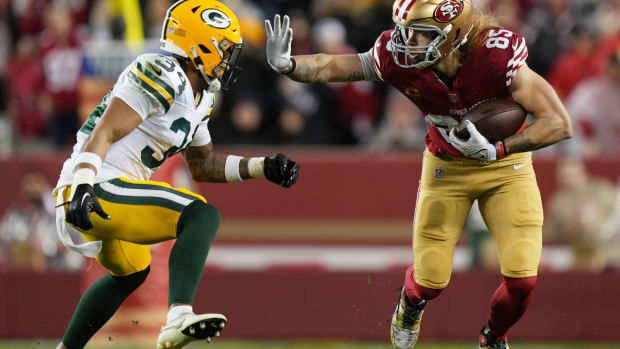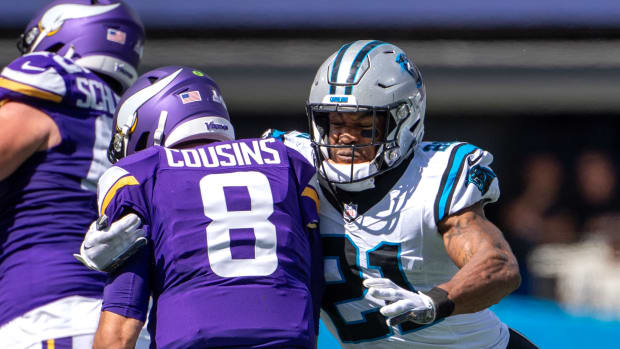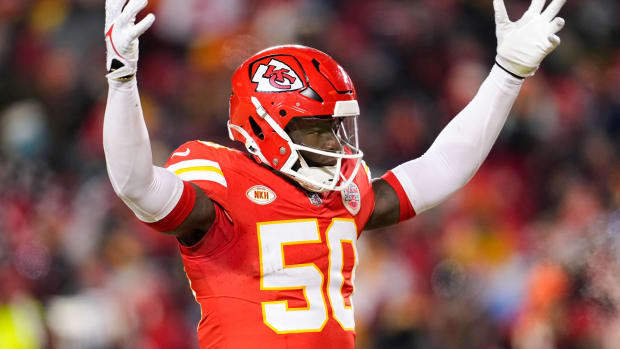Draft This Dude: Donnel Pumphrey will make you pay for letting his size spoil his stats
If you demand a running back be of the bruising, 220-pound variety, perhaps it’s best to turn back now. I mean, thanks for reading and please continue ... but this is going to require an open mind.
San Diego State running back Donnel Pumphrey is good. Really good. He is also, as of Senior Bowl weigh-ins, 5' 8" and 169 pounds. That’s about 20 pounds lighter than Darren Sproles, the player often cited as the prototype for “undersized” running backs; it’s two inches and 23 pounds lighter than the smallest back taken in last year’s draft, San Jose State’s Tyler Ervin, by the Texans.
Pumphrey, the all-time leading rusher in the FBS record books (although Ron Dayne would like a word) presents a bit of a challenge for the NFL. So, I’ll simplify it: This is a guy you want on your team.
2017 NFL Mock Draft 6.0: Post-Super Bowl look at the first three rounds
Pumphrey rushed for 6,405 yards in his San Diego State career on 1,059 carries—a heavy workload against some suspect defenses, both inside and outside of the Mountain West Conference. The goal, though, is the same as with any prospect, small-school or major-program, which is to uncover traits that translate to the next level.
The yardage total wasn’t a gimmick. Pumphrey is a patient runner with a burst. Case in point: This run vs. Cal. Pumphrey waited for a pair of blockers to get out in front of him, set up the defense by angling wide, then planted and found a hole for a substantial gain.
There is a difference between being a shifty back and being one that dances too much in the backfield. The former is far more effective, and that’s where Pumphrey falls.
Another example here, from San Diego State’s bowl game against Houston. On that run, Pumphrey was operating out of the I-formation, a fullback in front of him. But he didn’t run down his lead blocker. Instead, he probes an inside gap—drawing in a linebacker—before cutting outside behind that FB block. The aforementioned burst then showed up again, as Pumphrey dodged a tackle attempt and accelerated up the sideline.
The ability to make defenders miss is a key selling point for Pumphrey, in part because he’s not going to power through arm tackles much. There are times when he’ll lower his shoulder, invite contact and keep his legs churning for extra yardage (e.g. this 10-yard gain vs. Fresno State). When he is met head-on, however, especially near the line of scrimmage, Pumphrey often will be stood up or driven back.
The strength issue won’t go away. Even if Pumphrey bulks up to 175 or 180, he’s going to have moments when he is overwhelmed by NFL defensive linemen and linebackers. That happens to every back, to an extent, but Pumphrey is not going to live as a grind-it-out, between-the-tackles threat.
• Patriots fans: Get your Super Bowl commemorative issue | And framed Edelman catch cover
As seen in that big gainer against Houston, though, Pumphrey has the quick feet to make tackles miss—and miss quite a bit—in the open field. His compact frame actually helps him sharpen his cuts. There is almost no way for a defender to stick with him one-on-one if Pumphrey can catch him moving laterally or backpedaling.
All that said, his size will force Pumphrey into a third-down back role in the NFL, at least until he proves he can handle more. As an Aztec, he averaged 24.9 catches per season and 10.5 yards per reception. He may not be a natural hands catcher, per se, but again, the goal is to look for traits that translate. And Pumphrey’s elusiveness as a running back shows up when he runs routes, too.
This route, run against Wyoming, is one that would get him open about 99% of the time against NFL man coverage. Matched up with a linebacker, he broke off a quick little shoulder shake near the line of scrimmage, then made a terrific inside cut, caught the pass and flew upfield for almost 25 yards. (His propensity for letting the ball get into his body showed up there, as well, but didn’t hurt him on the play.)
When a running back shows as advanced an understanding for reading defenders as Pumphrey displays, that vision usually pays off in the passing game. Pumphrey sees the game one step ahead of those trying to tackle him.
Blocking will be a tall order on those passing downs—a 170-pound back trying to anchor against a blitzing, 250-pound linebacker will be a mismatch every time. But, to his credit, Pumphrey’s blocking did not show up as a clear weakness during his college career.
• 2017 NFL draft rankings: Chris Burke’s top 10 players at each position
Check out this play. Pumphrey helps chip a Wyoming defensive end before finding, and picking up, a linebacker coming on a looping blitz. The rest of San Diego State’s line imploded here, but Pumphrey’s effort helped turn what would have been an easy sack into an incompletion. While he may not have the raw power to stuff blitzers, he recognizes where he needs to be and does what he can to keep his quarterback clean.
Pumphrey does not have a growth spurt coming. He is never going to be viewed as a bellcow NFL running back. His hands (8 1/4") are red-flag-level small, which might help explain why he will let passes get into his gut.
Here's how to get Sports Illustrated's New England Patriots Super Bowl covers
There are concerns. There also are myriad reasons to believe Pumphrey can succeed at the next level. He displays the patience and vision of a veteran NFL back, paired with the quickness to burn defenses.
Want a power back that will wear down defensive fronts? Look elsewhere.
Need a playmaker that helps an offense spread the field and can pick up yardage in huge chunks? Pumphrey’s your guy.




































